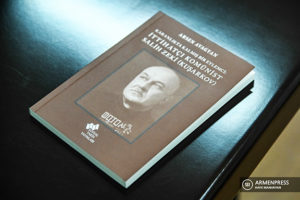
‘Monster Zeki’: Armenian Diplomat Reveals Mystery of Genocide Perpetrator
FEBRUARY 12, 2020 – ARMENIAN GENOCIDE – Salih Zeki (Kusharkov):
BY NORAYR SHOGHIKYAN
YEREVAN (Armenpress)—Salih Zeki (Kusharkov), the most brutal among the organizers of the Armenian Genocide, has been lying in the shadows of history for decades., the most brutal among the organizers of the Armenian Genocide, has been lying in the shadows of history for decades.
Arsen Avagyan, head of the Department of Bordering Countries at the Foreign Ministry of Armenia, Doctor of Historical Sciences, and professor at Yerevan State University, recently spoke to Armenpress about his study of the Ottoman, Russian, and Georgian archives, as well as his discovery of the mystery of Monster Zeki.
“Salih Zeki was born in 1883 in the city of Samsun, and was a Circassian by nationality. His father migrated to the Ottoman Empire in 1864 during the major emigration of Circassians from the Kuban region of Northern Caucasus,” said Avagyan. “In the Armenian sources, or in all memoirs relating to the Genocide or the events of that time, the name Salih Zeki is referred to as the ‘Monster Zeki.’ He first held a position in Everek in 1915 and, later, was the governor of Deir ez-Zor, which had the largest concentration camp. According to various reports, Salih Zeki organized the extermination of nearly 200,000 Armenians. The problem with Zeki is that there is minimal information about his life prior to, and following, the genocide. When we look at the sources, it seems he appeared in 1915, and disappeared after 1916,” he added.
Although Avagyan found information about Zeki through Ottoman, Russian, and Georgian sources, the Ottoman archives had nearly 210 officials with the same name who were in office at that time, and this in its turn confuses researchers.

“Due to the fact that I served twice as Armenia’s Permanent Representative to the Black Sea Economic Cooperation Organization from 2001 to 2005 and 2015 to 2019, and because my monographs and scholarly articles have been published in Turkish in Turkey – in other words I am quite known there – I was allowed to use and examine the Ottoman archive,” explained Avagyan. “I conducted research in the Ottoman archive for six years and collected various archival documents. There are also very important materials about Salih Zeki in the Russian archives. I have found a few materials from the Georgian archives, as well, because Zeki lived in Tbilisi from 1925 to 1933. As for the Azerbaijani archive, my Turkish historian colleagues provided me with some materials. Zeki played an important role in the establishment of Soviet rules in Azerbaijan, and this is proved by the archival documents. He has been the deputy chair of the commission for developing Azerbaijan’s Latin alphabet, as well as the editor-in-chief of the Azerbaijani Dai Yildiz journal and Yeni Fikir newspaper.”
Zeki played a major role in the implementation of the Armenian Genocide. He was appointed Governor of Deir ez-Zor for his known cruelty and brutality.
“Zeki was appointed Governor of Deir ez-Zor by the proposal of Governor of Syria Abdul Halik Renda. Moreover, Renda stated that the previous Governor of Deir ez-Zor was very compassionate towards Armenians – he didn’t kill them –and even provided conditions for the displaced Armenians. However, Renda needed someone capable of executing the plans made for the Armenians. He proposed Zeki’s candidacy, as the latter already had a major reputation in Everek with his cruelty,” said Avagyan. Many events in the history of the Armenian Genocide are connected with Salih Zeki, for instance Member of the Ottoman Parliament Grand Murad, together with his eight friends, were hanged by Zeki in Everek. Zeki also exiled the family of Sargis Torosyan, a hero of Dardanelles, by violation of law,” he added. Avagyan’s research showed that Zeki had even used Armenians who had converted to Islam as tools to kill more Armenians.
“Salih Zeki was using converted Armenians to kill Armenians. He told the converted Armenians that they must prove their faithfulness and kill their compatriots. Zeki also collected groups from the Chechens of the region and used them to kill Armenians. There are a number of eyewitness and survivors’ reports which mention Zeki’s name. Member of the Ottoman Parliament Emanuel Emanouilidis says he met with Salih Zeki in 1917, and was told by Zeki that he regretted the killing of 60,000 Armenians, including the burning of children, adding that he wanted to commit a suicide. In 1933, in his short biography written in Moscow, Salih Zeki, while describing the extermination of Armenians and the mass taking deportation, confessed: “As a Governor I bear a responsibility as I have taken part in that terrible act,” the Armenian diplomat said.
Zeki left Turkey in 1918. In 1920, he was sentenced to death by the Sultan, but this decision remained on paper –a mere document signed by a Sultan. Soon after, Zeki became a communist, and was given the surname Kusharkov.
“Zeki became a communist, and it’s worth noting that he worked with Armenians at that time. This individual cooperated with Armenian communists after killing thousands of Armenians. Moreover, Anastas Mikoyan became a source of help to Zeki during his days as a communist,” said Avagyan.
Several circumstances linked to Zeki contributed to his real, cruel identity remaining hidden for so long. The reports released in the Armenian media in 1918 also played a role in this.
“The Turkish historiography doesn’t deny the existence of Salih Zeki, but there is one problem: there is no study about him in the Turkish historiography. There is also one interesting factor – those who briefly touched upon Zeki provided an incorrect surname, thus contributing to his disappearance from the history,” noted Avagyan. The Armenian newspapers wrote that, in 1918, Zeki and his assistant were arrested and killed by Armenian legion troops near Beirut. According to other reports, Zeki was arrested and killed by Armenians in Syria. But, in reality, he was in Istanbul at the time, leaving for Baku in late 1918. He was afraid that he would be jailed for his crimes against the Armenians. And that happened,” he added.
Salih Zeki was also a target in operation Nemesis.
A number of the people that worked with him knew of his questionable past.
He died on November 3, 1940, at the age of 57 in Moscow.

asbarez.com/191594/monster-zeki-armenian-diplomat-reveals-mystery-of-genocide-perpetrator/
